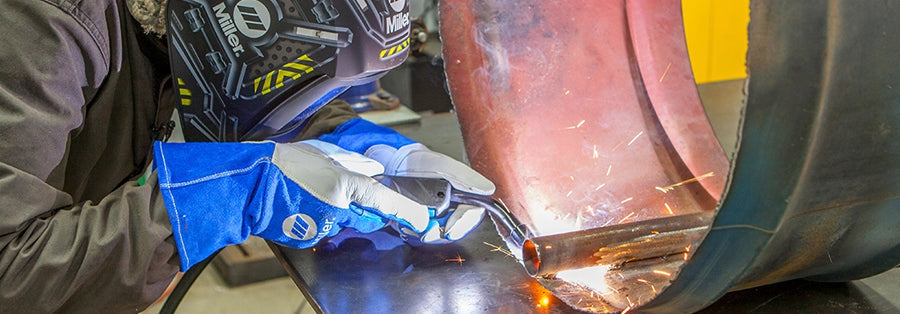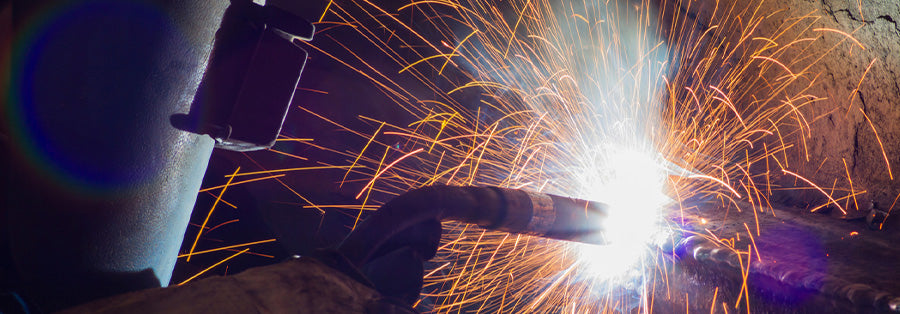How ironic is it that metal can withstand incredible pressures and high impacts like no other type of material, but its weakness is air and moisture. If your MIG weld is exposed to these elements, you might as well grind it off and start again. That, of course, is where using a shielding gas comes in. By flushing the area around your weld pool with specific types of gases, the corrosion-causing atmosphere is pushed away.

Which shielding gas you should use is often a debated topic. In some situations, the ideal gas solution will be based on personal preferences. In other situations, there is definitely a right or wrong gas type. In this article, we’ll cover everything you need to know to make the right decision for your MIG welds.
Generally, the easiest way to decide on which shielding gases you should consider is to start with the type of material you’re welding on.
Mild Steel
For many MIG welders, mild steel is your bread and butter. It’s cheap (in comparison to other materials) and is often considered the easiest metal to weld on. This makes it ideal for both beginners and experienced welders.
When choosing a shielding gas for mild steel, usually the first thing you should ask is, “How pretty do my welds need to be?” If your answer is “they can be ugly as sin, as long as they hold,” you should consider using 100% CO2 (Carbon Dioxide). Pure CO2 shielding gas is almost always the cheapest option. It tends to result in more spatter than other gas mixtures, but the welds themselves are quality. Often with MIG machines, 100% CO2 will be referred to as “C100.” For instance, the Millermatic 211 has a setting for “MIG steel C100.” This means you would use this setting when welding steel with 100% CO2 shielding gas.
The other common gas mixture for MIG welding mild steel is to use 75% argon/25% CO2. While this mixture is more expensive, it has quite a bit less spatter. This means it produces more visually pleasing welds. Often on machine settings, 25% CO2 will be referred to as “C25”. For instance, on the Millermatic 211, there is a setting for “MIG steel C25.”
In summary, let’s look at a few different situations you might face: Say you’re welding the underside of a vehicle. It won’t be visible to anyone, so using 100% CO2 shielding gas will be the most cost-effective option. In a different scenario, let’s say you’re welding a hand railing. Not only will your welds be visible, but no one likes using a railing covered in bumpy spatter. In this case, a 75% argon/25% CO2 would generally be considered best.
Aluminum
While lightweight and rust-resistant, aluminum can be a finicky material to weld. It can be highly sensitive to contamination, generally making any type of CO2 gas mixture a bad choice for a shielding gas.

Instead, the most common shielding gas for MIG welding aluminum is 100% argon. Due to argon’s low ionization value, it allows you to get into a spray transfer or pulsed spray transfer mode more easily. It is possible to use a mixture of helium and argon for MIG welding aluminum. These mixtures are often used in industrial situations but can be quite costly as helium is technically a finite resource. For this reason, unless you’ve become quite familiar with MIG welding aluminum, it’s often best to stick with 100% argon shielding gas at first.
Stainless Steel
If someone told you to describe stainless steel in one word, the answer should be: “Incre-sive” – That’s “incredible” and “expensive” mixed together. Stainless is a rust-resistant material. So unlike galvanized steel which only has a rust-resistant coating, stainless steel won’t rust, even if it’s scratched or gouged. Incredible.
As we mentioned though, it’s also expensive. As such, helium mixtures tend to be more commonly used with stainless than aluminum. Often the logic is that you’re already dropping a load of money on the materials, you might as well use a high-quality shielding gas.

That being said, helium mixtures are expensive. For this reason, it’s also semi-common to use mixtures such as 98% argon/2% CO2 for MIG welding stainless. Which gas type you should consider will depend on your machine’s user manual. For instance, the Millermatic 255 user manual states that if you’re using a Short Circuiting application to weld stainless steel, the proper gas would be 90% helium/7.5% argon/2.5% CO2. However, if you’re using a Spray Arc application for stainless, your gas options should be either 98% argon/2% oxygen or 99% argon/1% oxygen for flat, horizontal and fillet MIG welds.
Tips to Remember with Shielding Gas
Picking the right shielding gas is critical to ensuring quality welds. Beyond that, there are a few items that will make dealing with gas cylinders significantly easier. The first one is a welding cart. If you don’t already have one of these for MIG welding, you don’t know how much of a headache you could be avoiding. Instead of using a 100-foot gas hose, get a quality cart — one that will securely fasten your cylinder so you don’t have to worry about it tumbling over.
Any expert will also recommend a quality gas regulator and hose. If there’s a leak in your gas equipment, you’re quite literally letting your money vanish into the air. At Welding Supplies from IOC, we have all this equipment from the reliable brands you trust. Check out our full selection of MIG accessories here.






